2017 NISSAN ARMADA headrest
[x] Cancel search: headrestPage 20 of 614
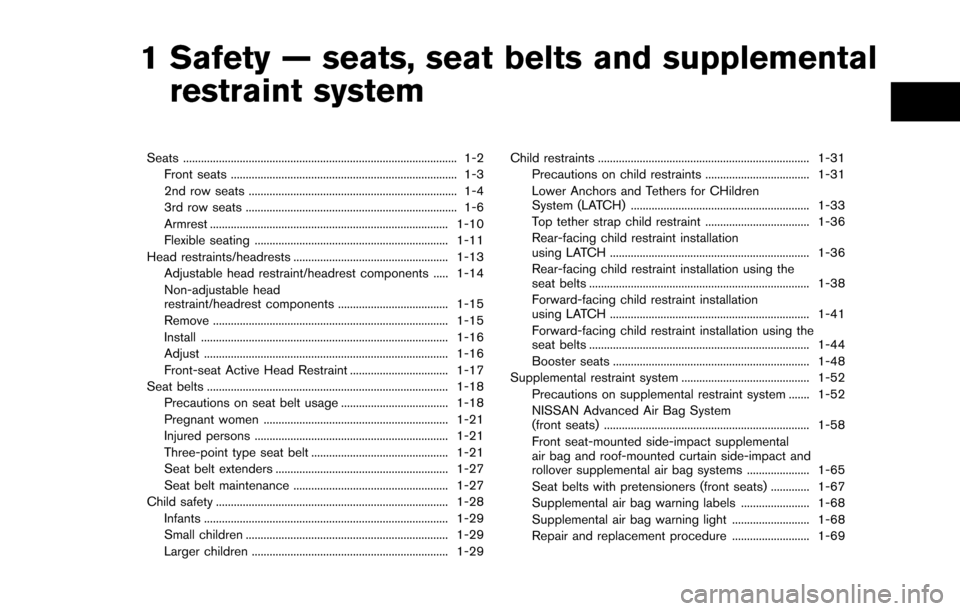
1 Safety — seats, seat belts and supplementalrestraint system
Seats ........................................................................\
.................... 1-2
Front seats ........................................................................\
.... 1-3
2nd row seats ...................................................................... 1-4
3rd row seats ....................................................................... 1-6
Armrest ........................................................................\
........ 1-10
Flexible seating ................................................................. 1-11
Head restraints/headrests .................................................... 1-13 Adjustable head restraint/headrest components ..... 1-14
Non-adjustable head
restraint/headrest components ..................................... 1-15
Remove ........................................................................\
....... 1-15
Install ........................................................................\
........... 1-16
Adjust ........................................................................\
.......... 1-16
Front-seat Active Head Restraint ................................. 1-17
Seat belts ........................................................................\
......... 1-18 Precautions on seat belt usage .................................... 1-18
Pregnant women .............................................................. 1-21
Injured persons ................................................................. 1-21
Three-point type seat belt .............................................. 1-21
Seat belt extenders .......................................................... 1-27
Seat belt maintenance .................................................... 1-27
Child safety ........................................................................\
...... 1-28 Infants ........................................................................\
.......... 1-29
Small children .................................................................... 1-29
Larger children .................................................................. 1-29 Child restraints ....................................................................... 1-31
Precautions on child restraints ................................... 1-31
Lower Anchors and Tethers for CHildren
System (LATCH) ............................................................ 1-33
Top tether strap child restraint ................................... 1-36
Rear-facing child restraint installation
using LATCH ................................................................... 1-36
Rear-facing child restraint installation using the
seat belts ........................................................................\
.. 1-38
Forward-facing child restraint installation
using LATCH ................................................................... 1-41
Forward-facing child restraint installation using the
seat belts ........................................................................\
.. 1-44
Booster seats .................................................................. 1-48
Supplemental restraint system ........................................... 1-52 Precautions on supplemental restraint system ....... 1-52
NISSAN Advanced Air Bag System
(front seats) ..................................................................... 1-58
Front seat-mounted side-impact supplemental
air bag and roof-mounted curtain side-impact and
rollover supplemental air bag systems ..................... 1-65
Seat belts with pretensioners (front seats) ............. 1-67
Supplemental air bag warning labels ....................... 1-68
Supplemental air bag warning light .......................... 1-68
Repair and replacement procedure .......................... 1-69
Page 32 of 614
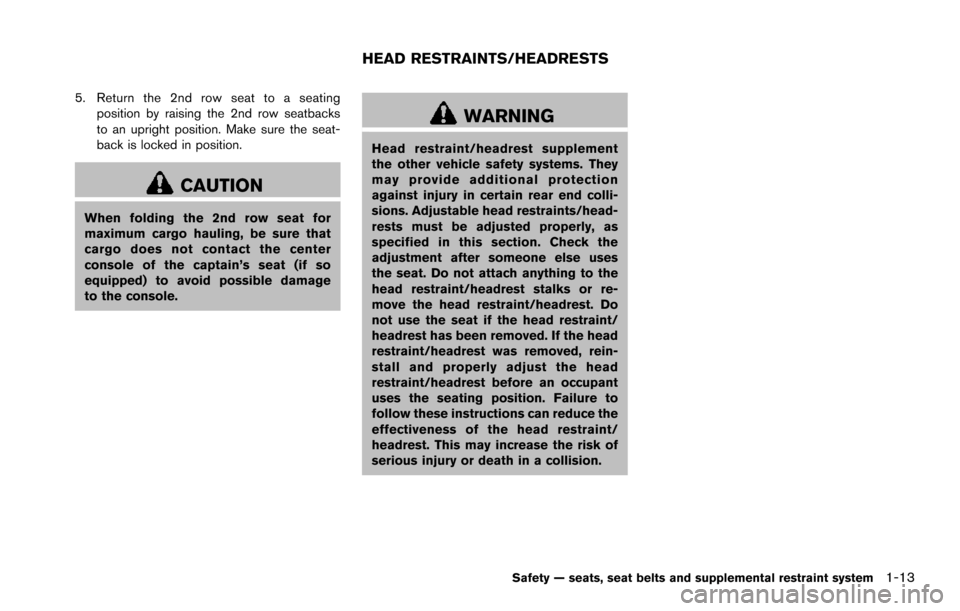
5. Return the 2nd row seat to a seatingposition by raising the 2nd row seatbacks
to an upright position. Make sure the seat-
back is locked in position.
CAUTION
When folding the 2nd row seat for
maximum cargo hauling, be sure that
cargo does not contact the center
console of the captain’s seat (if so
equipped) to avoid possible damage
to the console.
WARNING
Head restraint/headrest supplement
the other vehicle safety systems. They
may provide additional protection
against injury in certain rear end colli-
sions. Adjustable head restraints/head-
rests must be adjusted properly, as
specified in this section. Check the
adjustment after someone else uses
the seat. Do not attach anything to the
head restraint/headrest stalks or re-
move the head restraint/headrest. Do
not use the seat if the head restraint/
headrest has been removed. If the head
restraint/headrest was removed, rein-
stall and properly adjust the head
restraint/headrest before an occupant
uses the seating position. Failure to
follow these instructions can reduce the
effectiveness of the head restraint/
headrest. This may increase the risk of
serious injury or death in a collision.
Safety — seats, seat belts and supplemental restraint system1-13
HEAD RESTRAINTS/HEADRESTS
Page 33 of 614
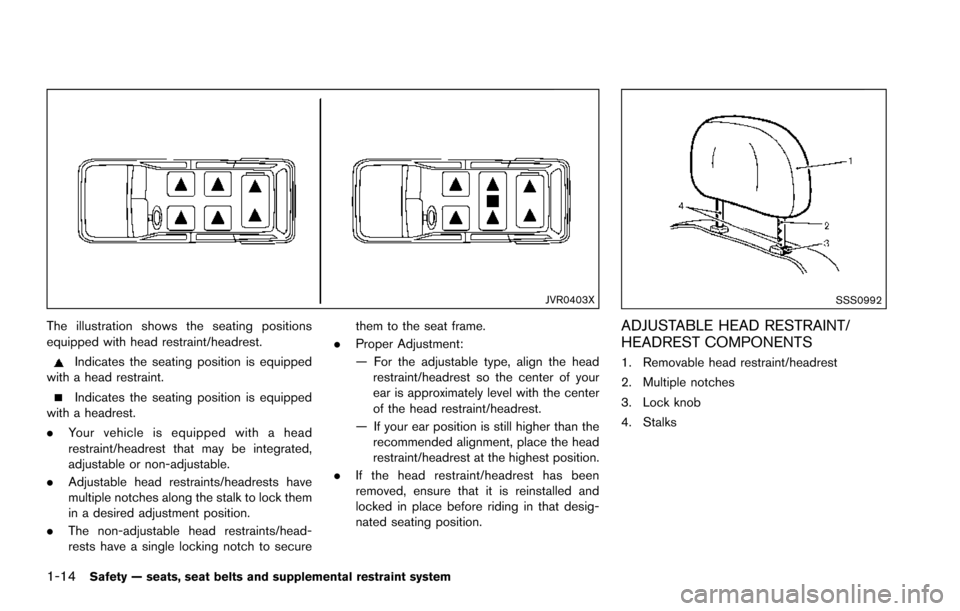
1-14Safety — seats, seat belts and supplemental restraint system
JVR0403X
The illustration shows the seating positions
equipped with head restraint/headrest.
Indicates the seating position is equipped
with a head restraint.
Indicates the seating position is equipped
with a headrest.
. Your vehicle is equipped with a head
restraint/headrest that may be integrated,
adjustable or non-adjustable.
. Adjustable head restraints/headrests have
multiple notches along the stalk to lock them
in a desired adjustment position.
. The non-adjustable head restraints/head-
rests have a single locking notch to secure them to the seat frame.
. Proper Adjustment:
— For the adjustable type, align the head
restraint/headrest so the center of your
ear is approximately level with the center
of the head restraint/headrest.
— If your ear position is still higher than the recommended alignment, place the head
restraint/headrest at the highest position.
. If the head restraint/headrest has been
removed, ensure that it is reinstalled and
locked in place before riding in that desig-
nated seating position.
SSS0992
ADJUSTABLE HEAD RESTRAINT/
HEADREST COMPONENTS
1. Removable head restraint/headrest
2. Multiple notches
3. Lock knob
4. Stalks
Page 34 of 614
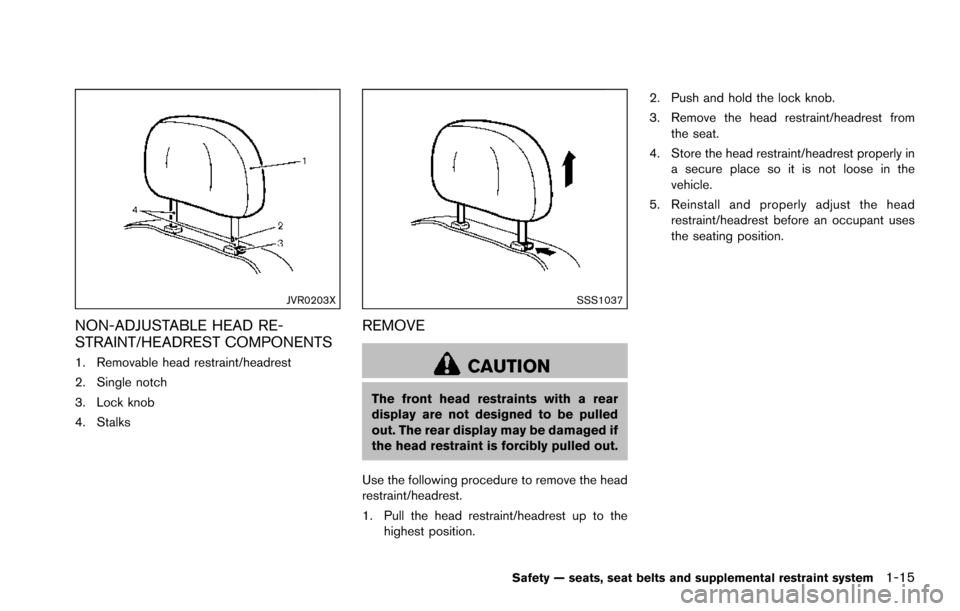
JVR0203X
NON-ADJUSTABLE HEAD RE-
STRAINT/HEADREST COMPONENTS
1. Removable head restraint/headrest
2. Single notch
3. Lock knob
4. Stalks
SSS1037
REMOVE
CAUTION
The front head restraints with a rear
display are not designed to be pulled
out. The rear display may be damaged if
the head restraint is forcibly pulled out.
Use the following procedure to remove the head
restraint/headrest.
1. Pull the head restraint/headrest up to the highest position. 2. Push and hold the lock knob.
3. Remove the head restraint/headrest from
the seat.
4. Store the head restraint/headrest properly in a secure place so it is not loose in the
vehicle.
5. Reinstall and properly adjust the head restraint/headrest before an occupant uses
the seating position.
Safety — seats, seat belts and supplemental restraint system1-15
Page 35 of 614
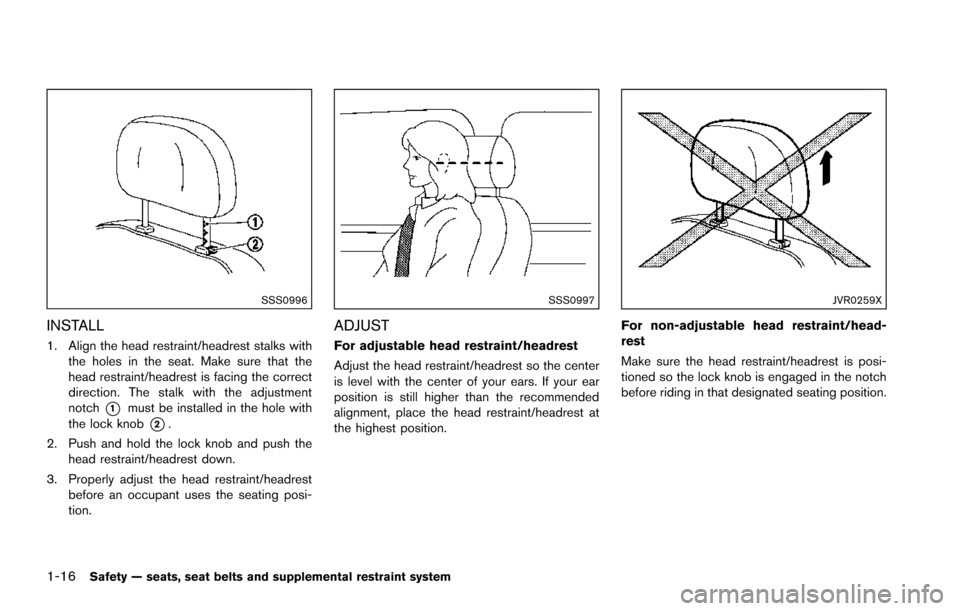
1-16Safety — seats, seat belts and supplemental restraint system
SSS0996
INSTALL
1. Align the head restraint/headrest stalks withthe holes in the seat. Make sure that the
head restraint/headrest is facing the correct
direction. The stalk with the adjustment
notch
*1must be installed in the hole with
the lock knob
*2.
2. Push and hold the lock knob and push the head restraint/headrest down.
3. Properly adjust the head restraint/headrest before an occupant uses the seating posi-
tion.
SSS0997
ADJUST
For adjustable head restraint/headrest
Adjust the head restraint/headrest so the center
is level with the center of your ears. If your ear
position is still higher than the recommended
alignment, place the head restraint/headrest at
the highest position.
JVR0259X
For non-adjustable head restraint/head-
rest
Make sure the head restraint/headrest is posi-
tioned so the lock knob is engaged in the notch
before riding in that designated seating position.
Page 36 of 614
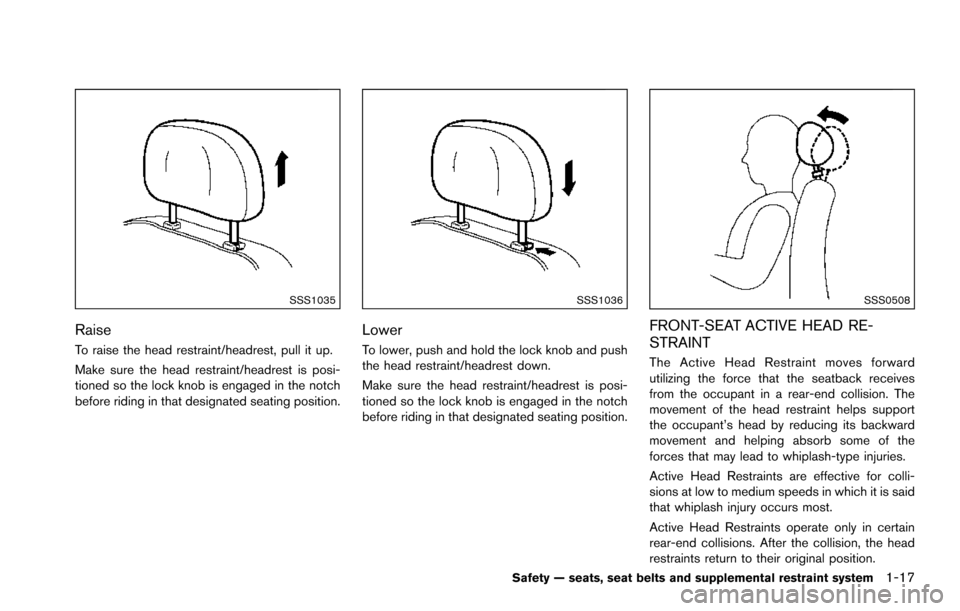
SSS1035
Raise
To raise the head restraint/headrest, pull it up.
Make sure the head restraint/headrest is posi-
tioned so the lock knob is engaged in the notch
before riding in that designated seating position.
SSS1036
Lower
To lower, push and hold the lock knob and push
the head restraint/headrest down.
Make sure the head restraint/headrest is posi-
tioned so the lock knob is engaged in the notch
before riding in that designated seating position.
SSS0508
FRONT-SEAT ACTIVE HEAD RE-
STRAINT
The Active Head Restraint moves forward
utilizing the force that the seatback receives
from the occupant in a rear-end collision. The
movement of the head restraint helps support
the occupant’s head by reducing its backward
movement and helping absorb some of the
forces that may lead to whiplash-type injuries.
Active Head Restraints are effective for colli-
sions at low to medium speeds in which it is said
that whiplash injury occurs most.
Active Head Restraints operate only in certain
rear-end collisions. After the collision, the head
restraints return to their original position.
Safety — seats, seat belts and supplemental restraint system1-17
Page 49 of 614
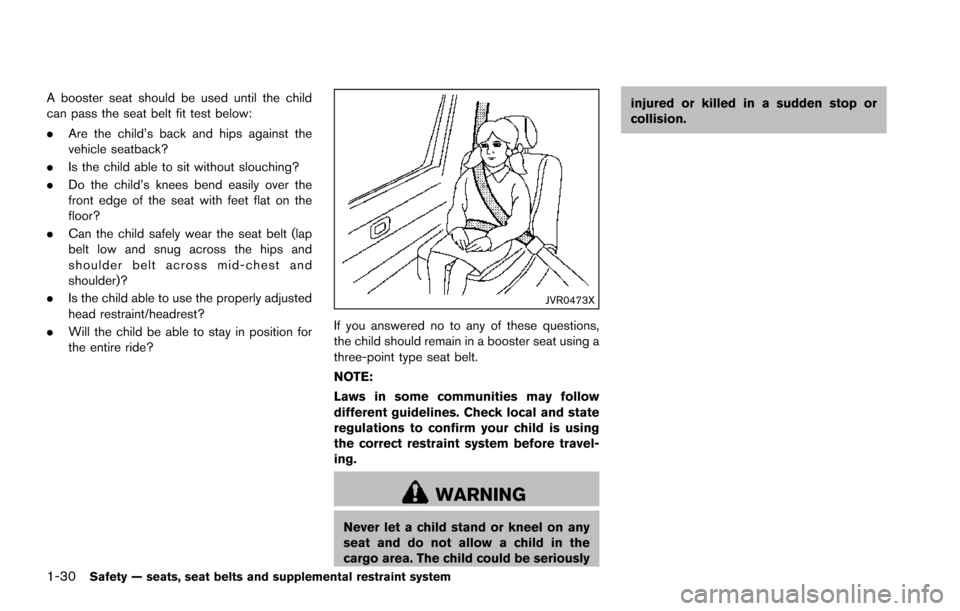
1-30Safety — seats, seat belts and supplemental restraint system
A booster seat should be used until the child
can pass the seat belt fit test below:
.Are the child’s back and hips against the
vehicle seatback?
. Is the child able to sit without slouching?
. Do the child’s knees bend easily over the
front edge of the seat with feet flat on the
floor?
. Can the child safely wear the seat belt (lap
belt low and snug across the hips and
shoulder belt across mid-chest and
shoulder)?
. Is the child able to use the properly adjusted
head restraint/headrest?
. Will the child be able to stay in position for
the entire ride?
JVR0473X
If you answered no to any of these questions,
the child should remain in a booster seat using a
three-point type seat belt.
NOTE:
Laws in some communities may follow
different guidelines. Check local and state
regulations to confirm your child is using
the correct restraint system before travel-
ing.
WARNING
Never let a child stand or kneel on any
seat and do not allow a child in the
cargo area. The child could be seriously injured or killed in a sudden stop or
collision.
Page 61 of 614
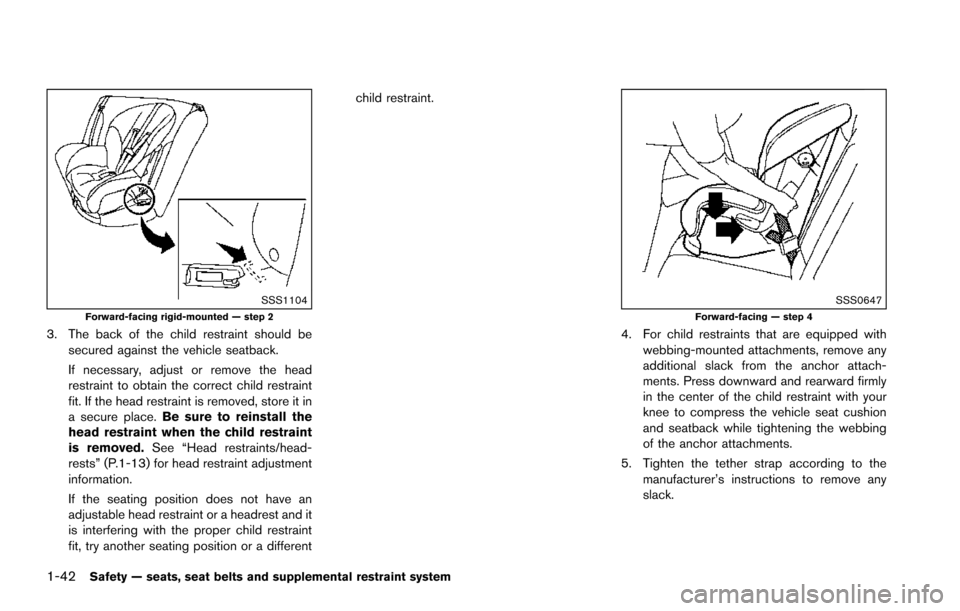
1-42Safety — seats, seat belts and supplemental restraint system
SSS1104Forward-facing rigid-mounted — step 2
3. The back of the child restraint should besecured against the vehicle seatback.
If necessary, adjust or remove the head
restraint to obtain the correct child restraint
fit. If the head restraint is removed, store it in
a secure place. Be sure to reinstall the
head restraint when the child restraint
is removed. See “Head restraints/head-
rests” (P.1-13) for head restraint adjustment
information.
If the seating position does not have an
adjustable head restraint or a headrest and it
is interfering with the proper child restraint
fit, try another seating position or a different child restraint.
SSS0647Forward-facing — step 4
4. For child restraints that are equipped with
webbing-mounted attachments, remove any
additional slack from the anchor attach-
ments. Press downward and rearward firmly
in the center of the child restraint with your
knee to compress the vehicle seat cushion
and seatback while tightening the webbing
of the anchor attachments.
5. Tighten the tether strap according to the manufacturer’s instructions to remove any
slack.